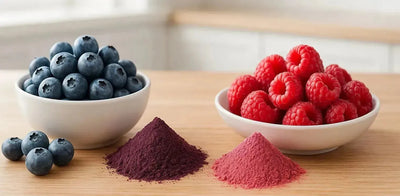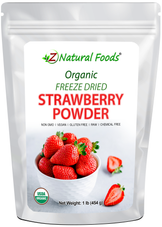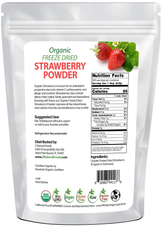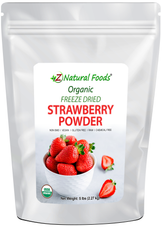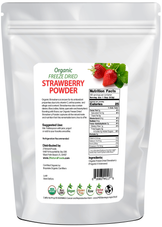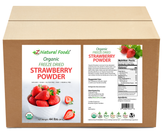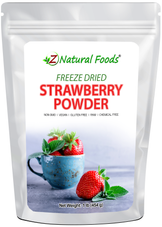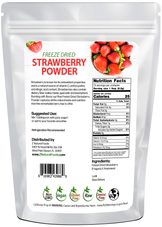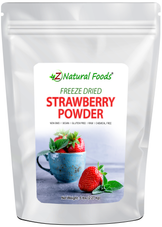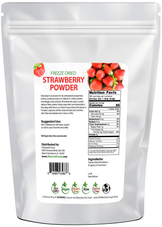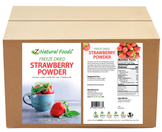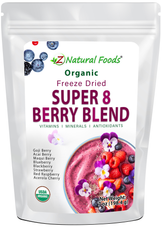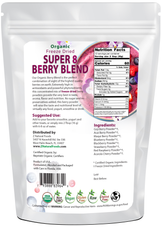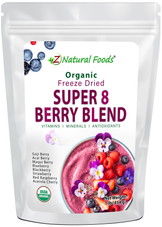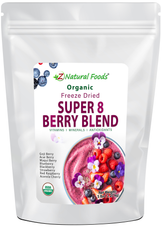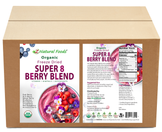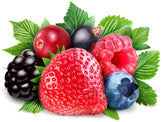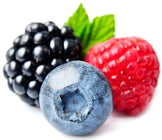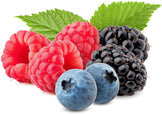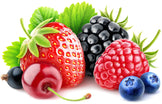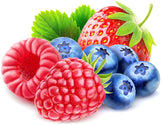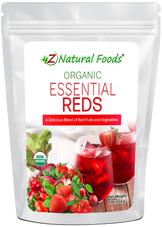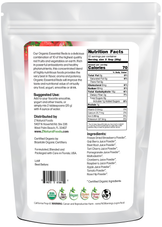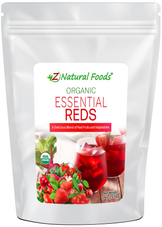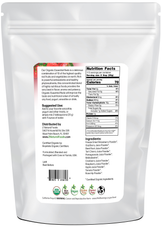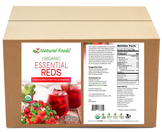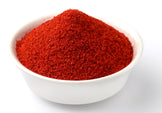Description
Description
Unless you have been living under a rock for the last 20 years, you have some idea about the highly nourishing qualities of berries, especially strawberries.
Modern research confirms the importance of adding foods with bright, vibrant colors that contain a wide range of potent polyphenolic compounds to support the repair process from the damage caused by stress, helping to create a more balanced internal environment.
With a beautiful, vibrant red color, strawberries are a fan favorite known for their sweet, delicious taste and versatility. Strawberries are used to create a wide range of tasty culinary treats, from innovative new beverages and sauces to classic desserts like strawberry shortcakes.
They have a visual apparel and flavor profile second to none. Today, we will answer two critical questions about these beautiful, bountiful berries, discussing the nourishing benefits of fresh and freeze-dried strawberry powders and their differences.
1) What is the difference between fresh strawberries and freeze-dried strawberry powder?
Thanks to modern technology in food preservation, not only can we extend the shelf life of food without adding preservatives and chemicals, but we can also create an end product that is highly versatile and as nutrient-dense as the fresh version.
While it is true that a powder version is not the same as eating a fresh strawberry, the idea that we can’t replace fresh food with a powder to nourish our bodies is simply untrue.
There are many significant advantages to using powders, especially strawberries. While there are many natural ways to dry foods and preserve their nutritional qualities, including low temperature, shade, air, sun, and freeze-drying, the quality of the raw materials predominantly determines the final product.
Ultimately, preserving the incredibly nourishing qualities found in strawberries is best obtained through freeze-drying. Unlike many other food preservation practices where unhealthy preservatives are added, in the case of freeze-drying, it is all about what is taken away.
The shelf life of any food or product is directly linked to its moisture content. A freeze-dried product has an average of only 3% or less moisture content. Because berries perish quicker than most foods, this method preserves their structure and integrity and significantly extends their shelf life.
So, freeze drying allows for greater versatility of the end product due to more accessible storage options and blending capability and supports the natural flavor profile of the fresh food version.
There are three primary advantages to using a freeze-drying method:
- Freeze drying creates the closest end product when presenting a whole food complex.
- Freeze drying a food presents closest to the smell, taste, and texture of the fresh version of a food.
- Freeze-dried foods allow you to customize your needs when creating a product, and freeze-dried berries can be left whole, chopped, or milled into a powder. All of which will still offer the nutritional value that comes from the fresh version.
A randomized control trial looking at the effects of consuming freeze-dried strawberries to lower serum cholesterol and lipid peroxidation in adults with abdominal adiposity and elevated serum lipids determined the following.
- The group that received a high dose of freeze-dried strawberries experienced a more significant decrease in total and LDL cholesterol.
- Both dosage groups showed a similar decrease in markers of cellular oxidative damage.
2) What are the benefits of freeze-dried strawberry powder
A Freeze-dried strawberry powder contains a treasure trove of nourishing compounds that are believed to support and maintain vibrant health. To understand the benefits of all the nourishing compounds found in fresh or freeze-dried strawberries, it is first essential to discuss the concept of synergy.
The primary principle behind synergy is understanding that the whole is greater than the sum of its simple parts. When applying this concept to strawberries, knowing that the potent compounds in various berries have a broader spectrum and nourishing effect than any individual compound within that mixture is essential. When eaten as a whole food matrix, no particular compound works alone.
Therefore, it is reasonable to conclude that all the compounds found in strawberries will provide more potent nourishment than consuming an isolated standardized compound.
Many health experts believe a diet focused on high amounts of flavonoids is critical to supporting a healthy aging process because these compounds are known as nature’s biological response modifiers. There are over 8,000 different types of flavonoids found in nature.
Based on the research, it does not seem to matter if you acquire them from food or supplements; what counts is the total daily amount you consume. These experts believe we should consume 500 to 2000 milligrams of flavonoids daily sourced from various foods and supplements. While results can vary based on numerous factors, the USDA Database for flavonoid content is a reliable source.
A randomized controlled trial discussing how flavonoid-rich foods improve microvascular reactivity and inflammatory status in men at risk for cardiovascular disease showed the following.
- The HF F&V diet increased endothelium-dependent microvascular reactivity
- Reduced C-reactive protein and vascular cell adhesion molecule
- HF F&Vs increased plasma NO in the group as a whole.
Therefore, the following was concluded, “These data support recommendations to increase F&V intake to ≥ 6 portions daily, with additional benefit from F&Vs that are rich in flavonoids, particularly in men with an increased risk of CVD.”
Strawberries possess unique qualities and compounds for various health purposes; they all fall under (at some level) these four general categories of plant compounds:
1) Polyphenols
Polyphenols are a term used to describe a general category of compounds found in a broad spectrum of fruits, vegetables, and tea that work as “reducing agents.” While over 8,000 polyphenols have been identified, some of the most common are flavonoids, flavonols, and anthocyanins.
2) Flavonols are polyphenols belonging to the flavonoid family with a ketone group studied for their wide range of biological activities(antioxidant, antimicrobial, hepatoprotective, modulating inflammation, and vasodilation). They primarily accumulate in the outer tissues(skin and leaves) of fruits and vegetables, are the building blocks of proanthocyanins(compounds attributed to the colors of fruits and vegetables), and are most widespread in the human diet.
3) Anthocyanins
Anthocyanins are a part of the flavonoid family of polyphenolic compounds. They represent the pigments that exhibit the bright red, purple, and blue colors found in fruits and vegetables. The six most common are Cyanidins, Delphinidins, Malvidins, Peonidins, Petunidins, and Pelargonidins.
4) Flavonoids are a group of water-soluble polyphenolic secondary metabolites found in plants thought to provide health benefits through cell signaling(The process when a cell responds to a substance outside the cell through signaling molecules found on the surface of that cell) and antioxidant effects. Secondary metabolites are substances manufactured by plants that make them compete in their environment, exerting a wide range of effects on the plant itself and the surrounding living organisms, including flowing, fruit setting, signal deciduous behavior, and acting as antimicrobials. Over 50,000 secondary metabolites have been discovered, and many modern medicines rely on them for their mechanism of action. There are six major subclasses of flavonoids: Anthocyanidins, flavan-3-ols, flavonols, flavanones, flavones, and isoflavones. These account for around 60% of all polyphenols.
Other unique compounds found in strawberries
Pelargonidin
Pelargonidin is one of the six anthocyanin compounds with the simplest structure, and while it is responsible for the red pigmentation found in strawberries, it is found in all berries. While some limited data shows unique characteristics of pelargonidin, there is no evidence for therapeutic amounts of pelargonidin as an isolated compound. The power of anthocyanins works synergistically, as no one compound in the family is more powerful than the whole. Some of the foods highest in this compound are strawberries, cranberries, plums, radishes, and kidney beans.
Ellagic acid
While often associated as a superstar compound found in pomegranates, ellagic acid is widespread in the plant kingdom, and berries are also uniquely high in this powerful compound. Ellagic acid (EA) is a bioactive polyphenolic compound naturally occurring as a secondary metabolite.
The following was stated in a review discussing the potential impacts of strawberries on human health. “There is accumulating evidence that much of the health-promoting potential of these plant foods may come from phytochemicals, bioactive compounds not designated as traditional nutrients. In strawberries, the most abundant are ellagic acid and certain flavonoids: anthocyanin, catechin, quercetin, and kaempferol.”
In conclusion, modern technology has allowed us to take foods that perish quickly and create a highly versatile food product that provides the same nourishing qualities with an extended shelf life. Strawberries' powerful qualities have been backed by quality science, and they are a delicious way to get great nutrition.
For more information about our Strawberry Powder, go here:
Freeze Dried Strawberry Powder
For more information about our Organic Strawberry Powder, go here:
Organic Freeze Dried Strawberry Powder
For more information about our Essential Reds powder, which also contains Strawberry Powder, go here:
For more information about our Super 8 Berry Blend, which also contains Strawberry Powder, go here:
